It’s not my very best favorite pescaderia. That honor goes to La Isla. Either at their new shop in Casa Collectiva or at their stand each Saturday at the San Miguel de Allende Organic Market. La Isla is, in fact, the only local retailer I know that, each week, consistently brings in fresh (and that’s really fresh, not previously frozen fresh) varieties of fish that I love to introduce to a heaping mound of crisp french fries.
One of my favorite fish is tuna. Yet, even though La Isla often has tuna, I usually buy my tuna from a shop other than La Isla. I, in fact, buy most of my tuna from what my great Aunt Alice, scowlingly, called a bottle shop (right after she put a bit more of her pension into Seagram’s stock). I buy my tuna from La Europea, a liquor store. Because La Europea has some absolutely amazing tuna.
Now I’m going to tell you something next that might shock you. That might make you stop reading this blog. But please bear with me.
The tuna at La Europea comes in cans. Still with me? Good, then let me explain that I’m not talking about those cans with bumble bees, clover leaves, some guy called Charlie, chickens of the sea, kisses by a star, or gold seals on the label. These are cans that hold some of the world’s most wonderful tuna. Tuna that is treated as only the very best tuna should be treated. Tuna that is packed in olive oil.
Canned tuna used to be a staple in my life, particularly in my struggling student life. It was up there (or should that be down there?) with bologna, mac and cheese, sardines and chicken wings. In those days, tuna came packed in vegetable oil or, even better, in olive oil. And then something happened. I’m not sure when or why. It’s said that it had something to do with the U.S.A.’s valiant fight against obesity. But I think it’s because oil is not only heavier but a helluva lot more expensive than water.
So those round five ounce cans, the ones that found double duty when we couldn’t find a hockey puck at the bottom of the equipment bag, became stuffed with water. And when we’d hung up the skates and opened them, held them over the sink, and pushed the serrated lid down into the can to drain the water, we squeezed a lot of that tuna taste away with that water.
But there are a couple of places in the world – namely Italy and Spain – that still celebrate the joys of tuna. That still pack tuna in olive oil. That know that olive oil actually protects the flaky texture. That know that oil helps retain the delicious and almost unique taste of tuna.
There is one Spanish brand and two types of tuna that I buy at La Europea. And I only buy it when it’s on special which, fortunately seems to be almost always. The brand is Pescamar. The two types are bonita del norte and atun claro. And even if your Spanish is so good that you can watch the Grand Hotel series on Mexican Netflix without the subtitles, you might need a little help with the names on the cans. For neither one tells you what type of tuna is inside.
Bonita del norte is my favorite of the two. Not so much because I prefer the taste, but because I prefer the texture. Bonita del norte comes as one solid chunk of meat. Atun claro comes flaked.
Bonita del norte is albacore tuna. Now if you’re a purist you might be saying that albacore isn’t really a tuna but, when it tastes this good, Don Day doesn’t care what you call it as long as you don’t call me late for the casserole. The norte part of the name refers to the north of Spain where, in and around the Bay of Biscay, albacores spend their summers, fattening up on a couple of my other favorite sea dwellers, anchovies and squid. Then, in August, September and October, fisherman, mostly from the Basque area, head out with their lines for the harvest.
Yes, I said lines. Each tuna is caught by the old fashioned rod and reel method, not with nets. It’s believed (particularly by the Japanese) that the stress caused by net methods actually changes the quality of the meat and the ventresca or belly of the bonita del norte is what is used for toro, one of the most prized toppings on a block of rice in any good sushi bar. The line method also assures that dolphins, who tuna like to hang out with so they’re protected from sharks, are not harmed.
I have three favorite ways to eat bonita del norte tuna. The first is on a salade nicoise which is so good it may receive a dedicated post on the blog. But not today.
The second is the way that Spaniards usually eat it, stuffed inside piquillo peppers, while sitting at a tapas bar. Now, if I knew how to do a sidebar on my blog, I would say something about desperately looking for a Mexican equivalent to piquillos and welcoming suggestions from those who know much more than me about local peppers. But because I haven’t found a local pimiento that compares, I have to settle for Spanish piquillos. And where do I get piquillo peppers in San Miguel de Allende you might ask. Yes, of course, La Europea again. They sell two brands, Bogador and Cayo. You want the Bogador because it’s less than half the price.
And the third and very best way I like to eat canned bonita del norte? Well you’ll have to wait for that because it’s one of Don Day’s Wife creations and I’m not going to hand over the Remington Rand to her until I’ve told you about canned atun claro.
But even before I do that, one last thing about bonita del norte and not from me but from someone with way more creds than me. Coleman Andrews, the Editor-in Chief of Saveur, wrote that Bonito tuna is “one of the great gastronomic pleasures of everyday life.”
OK, now the other type of tuna I buy in a can. Pescamar atun claro is much better known as yellowfin tuna. Yes, yellowfin tuna, that tuna we quickly sear on the outside and eat almost rare. That tuna that at San Miguel restaurant Hecho en Mexico is one of the town’s very best bargains. That tuna known in sushi bars as another of the most desirable flavors and, by name, as ahi tuna.
Yellowfin is a little fattier than bonita del norte. It’s a little darker with a slightly richer taste. But the texture is a little grainier making it more appropiate for recipes where it’s going to be combined with other ingredients. Like a perfect tuna salad sandwich with green onion, celery, mayonnaise, salt and pepper, capers and a squeeze of lemon. And at least half an inch thickness of those goodies between those two slices of crusty sourdough.
Canned tuna is up there with the underwater torpedo, the fridge and the electric drill as one of the four greatest contributions to the world from the country of Australia but I’m now going to give the typewriter to the lovely and talented Don Day’s Wife who will give you her greatest contribution of what you can do with canned tuna.
DON DAY’S WIFE’S SPAGHETTI ALLA PUTTANESCA CON TONNO
This isn’t an original recipe. Just a variation on a classic. When I just looked on the internet, I found that even Jamie Oliver has a puttanesca sauce that includes tuna.
My inspiration to include tuna actually came from a San Miguel de Allende chef, Gaetano Caronia of Osteria La Mia Italia at 20 de Enero and Orizaba. It was Gaetano’s Pizza Fantasia, that combines tuna with some very traditional Italian ingredients that made me recognize how well they worked in harmony.
Salsa Puttanesca has never been a rigid recipe since it became popular in the seventies. It translates as “whore’s sauce” and one of the popular stories of its origin is that it was how the ladies of the evening spiced up the sauce on the stove after the johns had all left.
The version from Naples doesn’t include anchovies and chilis; mine does. Most recipes include black olives; I like the slightly milder taste of green olives. I include cremini mushrooms but I don’t think there’s much of a loss if they’re left out. And I’ve made it without the roasted red peppers without them being missed.
What I like best about a pasta with puttanesca sauce and bonita del norte tuna is that I almost always have every ingredient in the house and I can whip it up in about half an hour. Some of the favorite words I can ever hear are, “Grammie, can you make me tuna pasta.”
The ingredients and recipe (serves two)
4 cloves garlic, chopped
6 tbsp. extra virgin olive oil
150 grams of cremini or white mushrooms, sliced
2 tbsp. dried basil
1 tbsp. dried oregano
¼ cup chopped green olives
6 anchovy fillets chopped (or 2 tbsp. of anchovy paste)
2 heaping tsp. jarred capers
½ tsp. red chili peppers (or to taste)
Black pepper to taste (I don’t add salt as the olives, capers and anchovies are salty)
½ cup chopped roasted red peppers (I use bottled rather than fresh if that’s what I have in the cupboard)
6-8 small, ripe plum tomatoes, roughly chopped, or a pint of cherry tomatoes (or canned San Marzano tomatoes)
One 220 gram can of Pescomar Bonita del Norte albacore tuna in olive oil
2 cups fresh, washed baby spinach or arugula (optional, but makes Grammie feel like she’s giving the grandkids all the food groups)
½ cup shredded parmesan reggiano (splurge for the Italian, not the Uruguayan or Mexican)
250 grams of dried spaghetti (or other pasta)
Saute garlic and chopped anchovies in olive oil until tender. Add mushrooms and cook until they’re tender. Place olives in food chopper and grind – if you don’t have a chopper, chop finely by hand. Add to mushrooms, anchovy and garlic and saute for a minute. Add capers, basil, oregano, chili peppers, red pepper, and tomatoes.
Cook covered over low heat until the tomatoes are soft, pressing them with the back of wooden spoon to release juices – add a bit of water if too dry.
Add tuna and arugula or spinach and heat through while trying to leave the tuna in chunks. Sprinkle with shredded parmesan cheese.
Add pasta cooked to al dente firmness, toss and serve. Sprinkle on additional dried chilis and chopped fresh basil and oregano if desired.
La Europea is located at Canal #13 in San Miguel de Allende, Mexico.



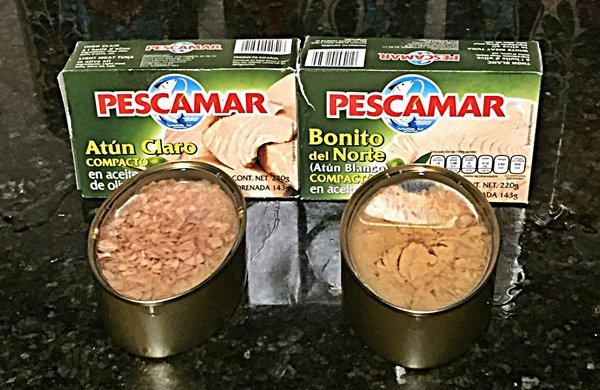
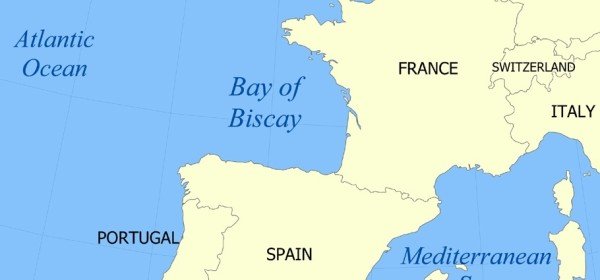
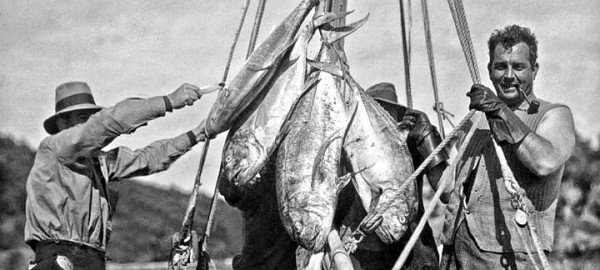
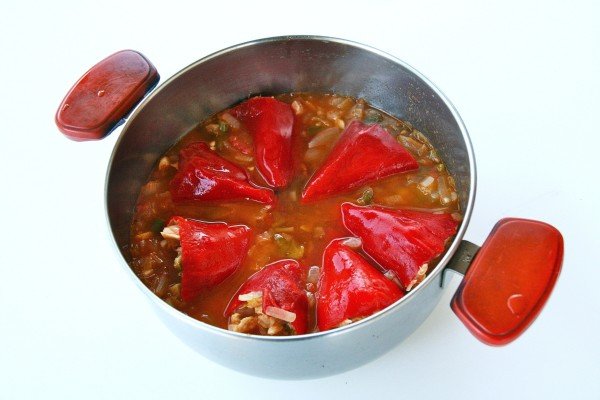
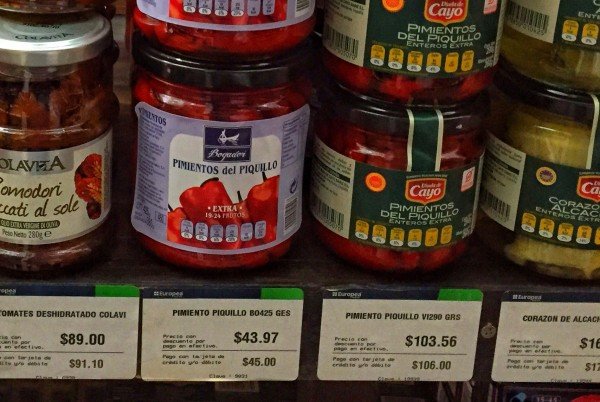
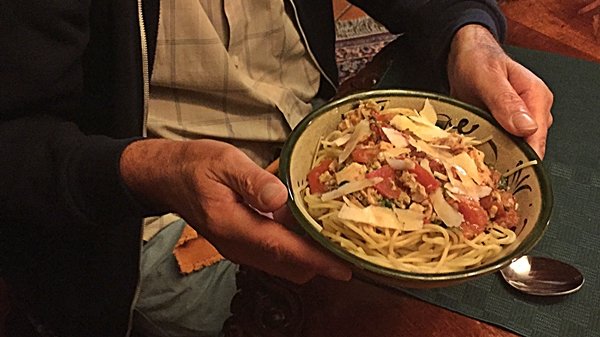
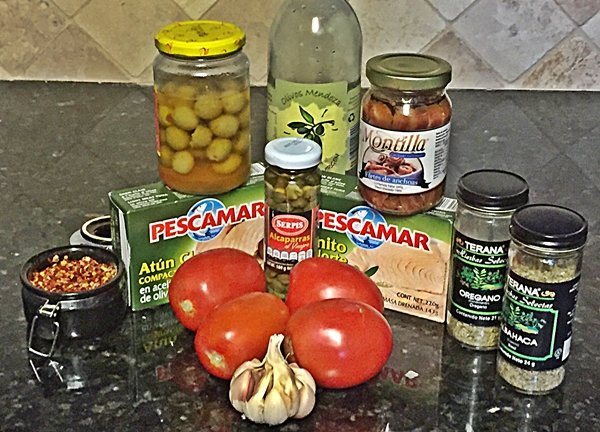
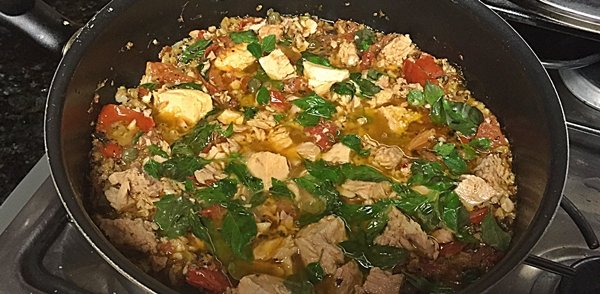
I’ve eaten Mrs Don Day’s tuna pasta many, many times and it is fabulous!
Wow! This is one for the archives! Thanks for sharing.